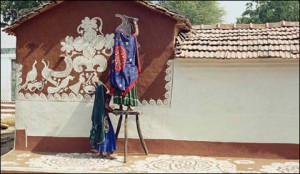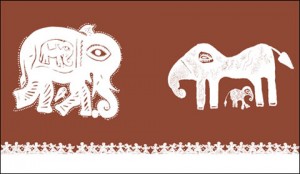Article first published on Blogcritics
If you ask people to imagine “an artist”, what you’ll probably get is an image of a Renaissance man in a linen smock, or a slightly modernised equivalent. What you’re unlikely to get is an Indian peasant woman in traditional dress perched on a rough country ladder, painting the side of her house.
But browse through the pages of Nurturing Walls: Animal Art by Meena Women and the image in your head might well be changed.
Two short essays in the text explain and explore the women’s work, setting out how Mandana painting, as their work is term, is done by women from the Meena tribe in Rajasthan. It explains that the large tribe is concentrated as farmers in the Aravalli Hills, although they have a history as a warrior clan, which when overrun in the 11th century took to the hills as guerrillas, a role they maintained into the 20th century, leading to them being named by the British under the “Habitual Criminals Act” of 1930 as robbers and criminals whose movements needed to be curtailed.
Yet there’s nothing of this surely turbulent history in the images of this tradition, although perhaps a hint in the fact that it’s a temporary art, meant to be painted over again and again, as the chalk on mud fades. (Then again perhaps that’s simply a reflection of art has it has surely been through most of human history – a pleasurable creation to be immediately enjoyed, before we distorted it with the destructive effects of the market. And it gives a hint of how much of human artistic history we’ll never be able to recover through archaeology, except through the most unusual accidents of preservation.)
The style certainly broadly fits within that tradition somewhat patronisingly called “naive”, in that there’s no focus on realism, or the rules of perspective or many rules at all really (except one that’s probably largely practical – the great majority of the images are white chalk on brown walls).
And the skill of the artists, as you’d expect, varies – but the best of it here is truly stunning – captivating in its depiction of a playful love between animal mother and child, innervating in its lithe energy.
What’s presented here is the images in close-up detail on roughly half of the pages, on a large number of othersvivide colour photographs of the work in situ and the artists in action, and a couple of essays.
If I’ve one criticism, one frustration with this book, it is that we don’t hear from the women artists themselves. The essays are by Madan Meena, a man from the tribe, and Gita Wolf. And they feel very much like the commentary of outsiders, worthy enough as they are, but wrapped in an intellectual tradition wholly foreign to that of the artists. Perhaps what the women would say about their art would sound to our ears very simple – and almost certainly self-deprecating – but I’d like to have heard it.
Nonetheless, on balance this is a very fine, worthwhile book, and I’m pleased that the names of the artists have at least been recorded where possible.
In the age of the eBook, Tara is offering something very different – the “art” pages of this book are hand screen-printed, the binding and stitching completed by hand, and the whole created from handmade paper, (“made from a ixture of cotton cloth waste and tree bark, rice husk or grass”). In the hand (and even in its smell), it feels different, and special.
It seems perfectly suited to this text, but browsing through the catalogue of this surprising publishing company, it is clear that they aren’t simply concerned with “matching” topics. Other books present the work of early 20th-century German poets and contemporary Western philosophers – truly worth exploring.
(UK purchasers are directed to the local distributor.)



 About
About
One comment
Pingback: Philobiblon – Green politics, history (particularly women's … | Welcome2Green